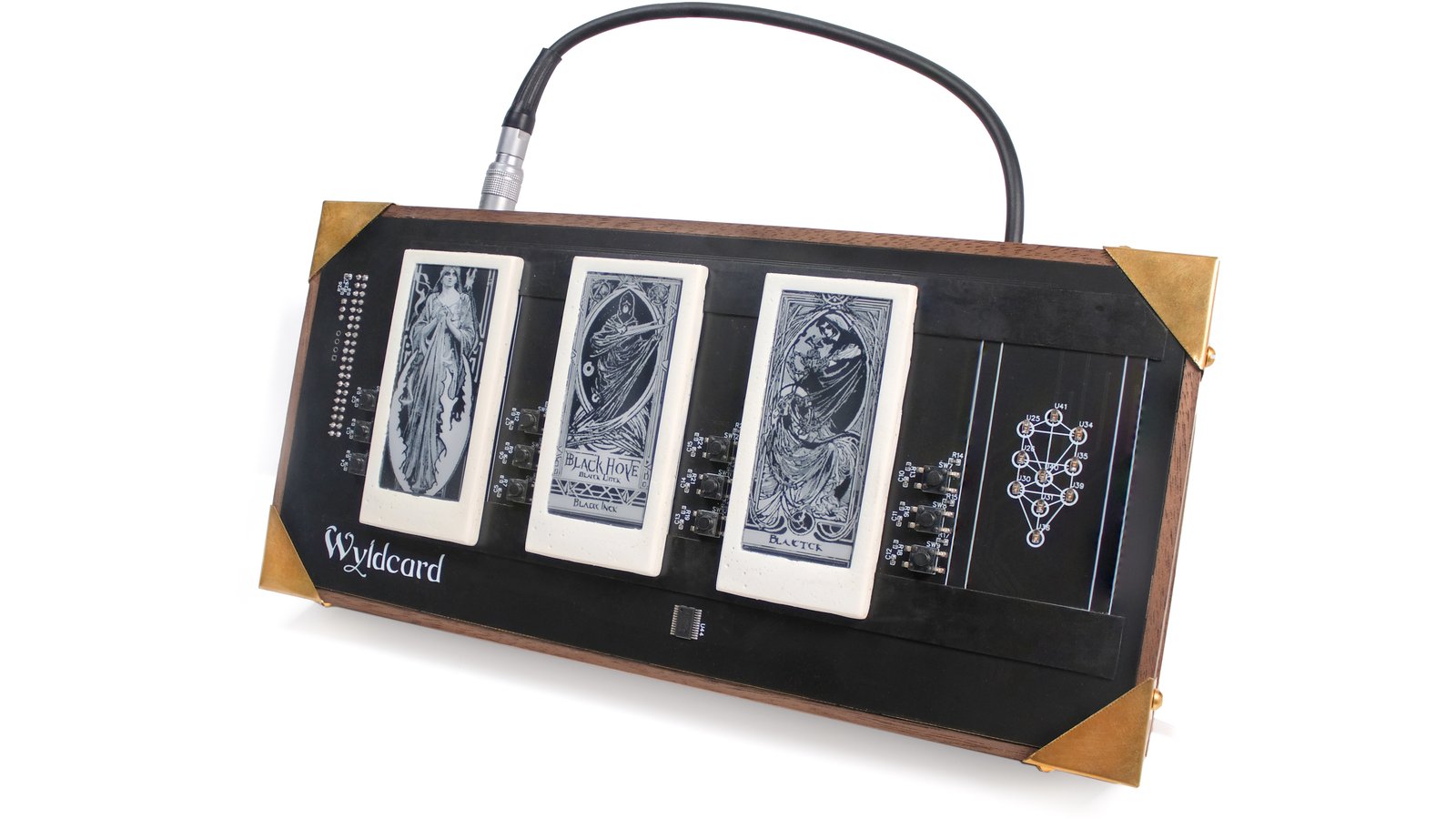Wyldcard explores a new paradigm in tabletop gaming: plastic cards with e-paper screens that meld the physical and the digital. Snap them onto a Plinth and the pictures on the cards can change as you play the game. With built-in memory, Wyldcards can persist stats, log moves, and track status effects. Connect your Plinth with a friend’s to collaborate or compete. We’re launching the first Wyldcard DevKit, giving creators the ability to experiment with the platform and explore this new interaction-space.
Wyldcard makes it possible to implement a number of game mechanics that just aren’t practical with paper playing cards:
The Wyldcards themselves do not have batteries. E-paper displays (like that of a Kindle) will keep their image for months without any power. They’re completely passive but can come to life when placed on a Wyldcard Plinth. The plinth contains a battery and small computer that runs the game mechanics.
Each Wyldcard is equipped with a small memory chip that can store stats and game data. A Wyldcard serves as a vessel for a game element, and the sprite that represents it, without being bound to a particular player or Plinth. These game elements becoming active during play.
Wyldcard DevKits ship with a JavaScript SDK for implementing your own games. Leverage simple abstractions to assign a behavior to each button on the plinth, display images on the Wyldcards, and send messages over the link cable. See our GitHub repo for sample code and tutorials.
Wyldcard DevKits ships with a simple demo application that displays random images on cards and a game implementation that simulates drawing cards from a Tarot deck.
Wyldcards are appropriate for many different applications. While we invented these cards with games in mind, others in our community have thought of various creative uses, such as stage magic, labeling, immersive art installations, escape rooms, and fancy showpieces, to name just a few examples. The open programming platform provided by our SDK does not restrict you to game-specific formats.
A Wyldcard Plinth with three Wyldcards. Includes everything you need to experiment with the Wyldcard platform. (If you want to develop two-player games, you’ll need another kit for the other player).
Three Wyldcards, pre-printed with a random image. You will need a Wyldcard DevKit to change the image on the cards. These are intended as an expansion to your Wyldcard DevKit, for games and other applications that require more than the three cards included with the kit.
Wow, you’re fancy! And so is the Deluxe DevKit. It includes an extra-fancy programmable Wyldcard Plinth and three Wyldcards. We broke out the Japanese block planes for the handcrafted black-walnut plinth and fashioned our own brass fittings by hand. The Deluxe DevKit includes everything you need to experiment with the Wyldcard platform. (If you want to develop two-player games, you’ll need another kit for the other player. They don’t have to be as fancy as you are.)
The open source Javascript SDK with documentation and sample code can be found in our GitHub repo. Tutorials and guides will be posted to the Wyldcard Blog. Open source schematics for designing your own Wyldcard-compatible hardware is also available in our GitHub repo.
If you have questions or need help programming, don’t hesitate to email us or join our Discord server.
On top of being a lifelong crafter and maker, Jonah has been managing teams at software and hardware companies for over five years. He knows how products get built! Wyldcards and plinths are built out of standard industrial components and production can be scaled as needed. They were designed from the very beginning with mass production in mind.
Wyldcards themselves are composed of a standard-sized e-paper screen, a simple custom-manufactured PCB, magnets, and a two-part epoxy resin poured into a silicone mold. If we need to ramp up production to over a hundred cards, we’ll switch to card enclosures milled from plastic sheet. If we get into mass production, we can switch to injection-molded card enclosures.
A batch of standard plinths is easy to produce in our woodworking shop. If we need to scale production up to more than 50 plinths, we can use a CNC router or laser cutter. We have optimized our component design to accommodate either option.
"Wait until psycho-reactive crystal [is] a real thing[?] Maybe not. E-ink might be close enough, if this prototype of Jonah Stiennon's Wyldcards is any indication."
"Jonah Stiennon's Wyldcard project has taken the internet by storm!"
Produced by Wyldcard LLC in Oakland, CA.
Sold and shipped by Crowd Supply.

A Wyldcard Plinth with three Wyldcards. Includes everything you need to experiment with the Wyldcard platform. (If you want to develop two-player games, you'll need another kit for the other player).

Three Wyldcards, pre-printed with a random image. You will need a Wyldcard DevKit to change the image on the cards. These are intended as an expansion to your Wyldcard DevKit, for games and other applications that require more than the three cards included with the kit.

Wow, you're fancy! And so is the Deluxe DevKit. It includes an extra-fancy programmable Wyldcard Plinth and three Wyldcards. We broke out the Japanese block planes for the handcrafted black-walnut plinth and fashioned our own brass fittings by hand. The Deluxe DevKit includes everything you need to experiment with the Wyldcard platform. (If you want to develop two-player games, you'll need another kit for the other player. They don't have to be as fancy as you are.)

· TinyTimZamboni · jonahss · wyldcard.io
Introducing a new paradigm in tabletop gaming: e-paper cards that can change